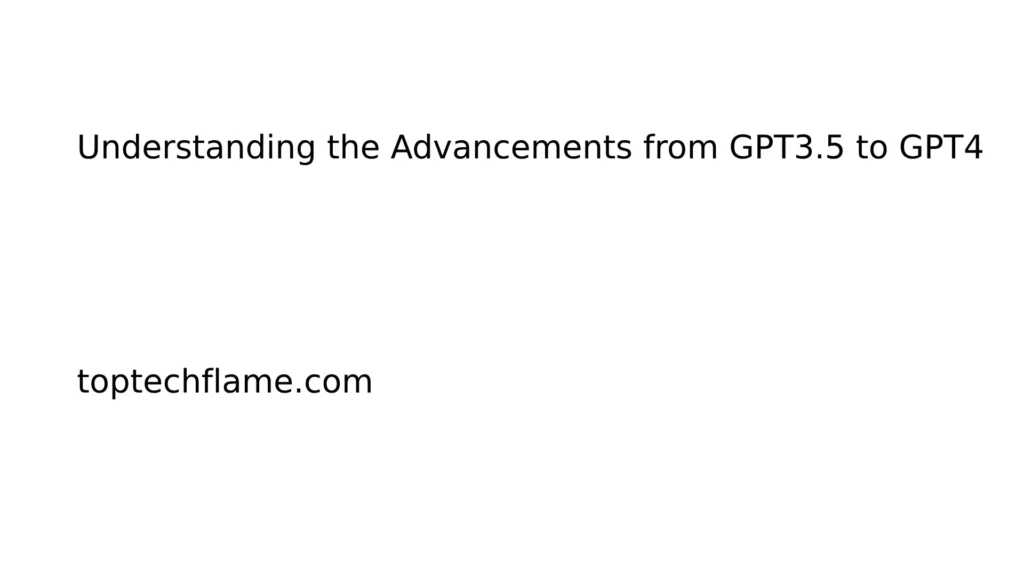Advancements from GPT 3.5 to GPT 4
Advancements from GPT 3.5 to GPT 4 is a technological marvel in the world of artificial intelligence. The main versions of advancements from GPT 3.5 to GPT 4, have seen massive changes in AI interaction with humans. Both models are highly advanced, and both are works of brilliance, though GPT 4 as a model has brought in a few significant advancements over the highly impressive GPT 3.5 model.
These updates in GPT 4 make it a much better option for users who require more accuracy, better understanding, and superior programming. In this article, we will discuss the updates from GPT 3.5 to GPT 4, compare them with their distinct features, and explore how GPT 4 improves user experience.
Advancements from GPT 3.5 to GPT 4 are language models developed by OpenAI. They are trained to understand and generate human-like text based on an input prompt. GPT 3.5 was considered one of the most powerful AI language models ever developed, able to write rich, high-quality text, engage in deep conversations, and even write code. Still, with the introduction of GPT 4, several new improvements have been made that make this tool even more powerful.
The biggest difference between the advancements from GPT 3.5 to GPT 4 is in training data size. GPT 3.5 utilized data with 175 billion parameters, while GPT 4 utilizes more than a trillion parameters. This means it will be able to solve much more complicated tasks and respond accordingly to those queries. This may make GPT 4 even more specified and comprehensive in the usage of text as well as the generation of text.
How Do I Use GPT 3.5 to GPT 4?
The advancements from GPT 3.5 to GPT 4 models are both on the ChatGPT platform by OpenAI, but there is a difference in terms of access. GPT 3.5 is free, and any individual with an OpenAI account can use it, whereas GPT 4 requires a subscription through ChatGPT Plus, which offers access for $20 per month. This obviously portrays how superior GPT 4 is in comparison with the capabilities it offers compared to GPT 3.5.
Although this is true, both versions are still so widely used in applications for mundane talk or complex problem-solving. However, the advancements from GPT 3.5 to GPT 4 make the latter the version of choice for users who need more precise and thoughtful answers, even those doing intricate things like advanced programming or content creation.
GPT 3.5 vs. GPT 4: Key Differences
1. More Parameters and Training Data in the advancements from GPT 3.5 to GPT 4:
The most relevant improvements in this area concern the increase in parameters and training data. Already a behemoth model with 175 billion parameters, GPT 3.5 takes that further with more than 1 trillion. This enables GPT 4 to be even more detailed, accurate, and contextual in its responses.
Another level of additional training data enables GPT 4 to address even newer information. As opposed to GPT 3.5, which was trained through data up to June 2021, GPT 4 is trained on data up to September 2021, making it more current and able to provide more informed responses.

2. Contextual Understanding Better in Advancements from GPT 3.5 to GPT 4:
One of the big improvements from GPT 3.5 to GPT 4 is its contextual comprehension. GPT 3.5 would sometimes lose coherence in long conversations or misunderstand the scope of the prompt. GPT 4 can hold up to 25,000 words of context for retention and consideration, compared to its counterpart, GPT 3.5, which holds around 3,000 words. A greater context window for GPT 4 allows it to give more coherent responses and consider multiple factors for more complex prompts.

For instance, when it comes to an intricate question involving several variables or subjects, GPT 4 will better grasp the overall context and more readily respond. The corresponding belief of GPT 3.5 is that some pivotal aspects would be overlooked, while its response may be trivialized. This advancements from GPT 3.5 to GPT 4 implies that the latter model would be very effective in the workplace or any other professional context where sophisticated and intelligent responses are required.
3. Reduced Hallucinations and Higher Accuracy:
Another major problem with big language models like GPT 3.5 is “hallucinations,” when the AI produces information that is simply incorrect or even entirely fabricated. GPT 3.5 was already guilty of this kind of flaw, particularly if it didn’t know much about obscure topics or was overcomplicated. GPT 4 has, however, reduced hallucination factors considerably;GPT 4 is far more likely to tell you it doesn’t know rather than manufacture an answer known to be false.
This is partly due to the fact that GPT 4 was trained on longer human input duration than its predecessors. Safeguards have also been placed through Open AI, making advancements from GPT 3.5 to GPT 4 an 82% safer alternative in matters of generating harmful or forbidden content.
4. Superior Programming Aptitudes:
Advancements from GPT 3.5 to GPT 4 is programming ability. Fortunately, GPT 3.5 to GPT 4 could produce code, but the tougher programming tasks usually made it fall short, and users often had to intervene to tweak the code. Advancements from GPT 3.5 to GPT 4 is a big step forward in better understanding programming prompts and producing more accurate code.
For example, if a prompt like “optimize this code” or “fix this error in the following function ” is given, GPT 4 is significantly more likely to generate a working solution than GPT 3.5. This is of special interest to developers who may want to leverage AI to speed their coding process; GPT 4 slashes debugging time considerably when working on code generated by AI.
5. Multimodal Capabilities:
One of the coolest developments of the advancements from GPT 3.5 to GPT 4 is the availability of multimodal capabilities. While GPT 3.5 only processes text-based input and output, GPT 4 can also understand images. Therefore, a user can input an image, and GPT 3.5 to GPT 4 can analyze it and provide context or relevant information.
For instance, if you upload a picture of what’s inside your fridge,GPT 3.5 to GPT 4 can suggest recipes based on the ingredients it sees. This opened up a wide view of possible applications, from creative efforts, such as generating art-given descriptions, to practical use, such as visual analysis.
6. Advanced Creativity:
GPT 4 has a better lead on creative tasks than GPT 3.5. Whether you require it to create a story, compose poetry, or brainstorm ideas, GPT 4 works much better as it churns out coherent and more interesting content. If GPT 3.5 gets lost in the plot and fills it with inconsistencies in a story, GPT 4 can maintain a defined structure and coherence for the creative project.
That makes GPT 4 uniquely useful to content creators, writers, and people relying on AI to generate quality, creative output. This version has better complex prompt understanding and thoughtful, well-structured responses that its precursor did not.
7. Safety Features Have Been Improved:
OpenAI has focused more on the safety aspect in GPT 4. The model has been designed to have an 82% likelihood of generating less harmful and inappropriate content. A milestone between GPT 3.5 and GPT 4 is because, from the general public’s viewpoint, the misapplication of AI technology could be questionable. That is to say, GPT 4 can be rather good at recognizing and avoiding sensitive topics while guaranteeing its responses are safe and suitable for a wide range of users.
8. Limitations and Response Speed:
Despite the numerous developments in the advancements from GPT 3.5 to GPT 4, there is some trade-off. GPT 4 is generally slower than GPT 3.5 in producing responses. This is because GPT 4 utilizes a greater extent window and takes more intricate processing to make more well-informed and thoughtful answers than GPT 3.5. GPT 3.5 goes faster and produces the response in seconds, whereas it could be lagging for more complex prompts or for developing a composition of substantial, nuanced answers.
For those not too concerned about losing depth as a concession to greater speed, GPT 3.5 may be the better choice in at least one sense. For those who need more detailed and accurate responses, though, the slower operating speed of GPT 4 is a small price to pay for its superior capabilities.
Use Cases for GPT 3.5 and GPT 4
The above differences between the advancements from GPT 3.5 to GPT 4 have thus made a huge difference in usage scenarios for both models, including GPT 3.5, which is still good for casual conversation, quick answers, and tasks that do not necessarily involve deep understanding or complex reasoning. It’s also appropriate for users who would appreciate an accessible AI tool without the requirement of subscribing to anything.
Instead, GPT 4 is more suited to professional or academic use, creative projects, or situations that demand serious or degenerative analysis. It is versatile for the education, health, and software development sectors because it can understand and process images along with advanced text capabilities.
Conclusion
The advancements from GPT 3.5 to GPT 4 , one of the most important leaps in AI language models, exemplifies artificial intelligence’s continued march toward more accurate, elaborate, and efficient responses. GPT 4, based on an already very strong foundation, introduces many key improvements across a wide range of applications, making it far more effective and versatile than its predecessor.
This would imply that the differences in performance between the advancements from GPT 3.5 to GPT 4 are due to significant increases in parameter size and much larger training data. While it was excellent for language capabilities, GPT 4 has more than a trillion parameters that take its predecessor far ahead. The expanded context window in GPT 4 also allows the model to understand multi-layered prompts better and have more in-depth conversations than is possible with GPT-3.5’s 3,000 words. In contrast, GPT 4 can realize up to 25,000 words. Improvement in this would be necessary as users want coherent and consistent responses for larger interactions.
It also reduced hallucinations, where an AI just creates information, for example, which improved its reliability and trustworthiness. This has made GPT 4 a far more useful tool for professional and academic use. More reliable and trustworthy, the AI is better at knowing its limitations and declining to give an answer if it is not sure rather than giving some wrong information.
In comparison, GPT 4 is far better at digesting and synthesizing information from many sources and handling prompt types that require a multifaceted approach. This improves enormously over GPT-3.5, as competent as it sometimes proved to be but which couldn’t hold attention or give informative, nuanced descriptions of complex issues. The way GPT 4 integrates different sources of information into a coherent response is highly useful for users who want to see detailed multifactorial answers.
Another impressive feature where the GPT 3.5 model surpasses the GPT 4 model is that the latter supports inputs other than text. While GPT 3.5 is text-based to a large extent, GPT 4 accepts images and voice prompts and thus functions in many more ways. This multimodal capability offers users new ways of interacting with AI, like receiving the visual interpretation of images and constructing code from a sketch. This unlocks creative and functional uses, such as analyzing data or generating innovative designs based on the observation from visual inputs.
Another point is that GPT 4 has further developed its coding capabilities initiated by GPT 3.5. It not only writes code but also refines it in successive iterations to make it more perfect with user feedback. This refinement has made GPT 4 a more practical developer tool, as it is efficient while debugging and optimizing code, hence taking less time off from debugging cycles.
Despite all this, GPT 4 has limitations. For instance, it will have a slower response time due to the increased context-processing capabilities. However, such trade-offs are relatively mild compared with the degree of development in performance overall and in a wider range of tasks it can do.
Advancements from GPT 3.5 to GPT 4 mean continuous improvement in AI technology. It is more holistic, reliable, and versatile than the previous versions. Thus, GPT 4 would be best for one looking for deeper insights, creative solutions, or more nuanced interactions. Whether in professional, academic, or even creative fields, GPT 4 stands as a testament to the rapid advancement of AI and its growing potential to revolutionize human-computer interaction.


